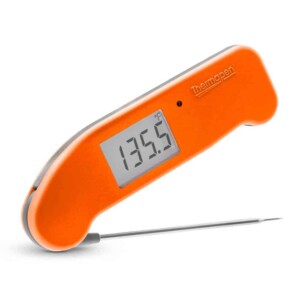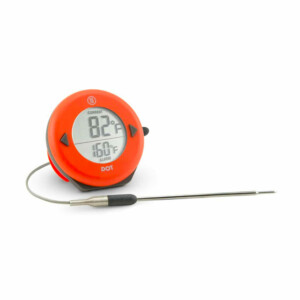ThermoWorks just announced that it’s going wireless! Pitmaster Christie Vanover was at their headquarters when they unveiled their first wireless leave-in thermometer – the RFX Meat.
In this week’s BBQ Tips Podcast she shares how the RFX Meat works and how it has overcome the problems that many other wireless thermometers face. She also explains the Thermoworks products that she uses regularly and what makes each one different.
Listen to the BBQ Tips Podcast on
This past weekend, I had the opportunity to go to a VIP event at the ThermoWorks headquarters.
If you don’t know about ThermoWorks, these are the best thermometers out there on the market in the culinary industry. Not only are they used by so many pitmasters, but they’re also used by restaurants, whether it’s barbecue or baking or just a regular fine dining restaurant.
These are the precision instruments that chefs and pitmasters trust, including myself.
So it was an honor to be able to go up to their headquarters for this culinary experience. When I saw the agenda, I was so excited because one of the agenda items was wireless thermometers.
I have been waiting for ThermoWorks to launch a wireless leave-in thermometer. And guess what? At this culinary experience event I just attended, they did.
So I’m going to talk to you about how the thermometer works, what makes it different from what’s already on the market, the price point and the expected delivery date. So stay tuned to this podcast that I’m going to give you the whole 411 on the RFX Meat.
The Thermapen
But first, I want to talk to you about ThermoWorks in general and why I love them so much. So the Thermapen is probably their best known thermometer.

Thermapen ONE
Check Price
This is a digital thermometer. They have an MK4 and they have a Thermapen ONE. You basically insert your probe into your meat and with the Thermapen ONE, you’re going to get a one-second reading. With the MK4, I think the reading is like two to three seconds and then it shows up on the digital display.
The display rotates depending on how you are holding the thermometer. It’s also backlit. It’s battery operated, but I’ve never had to change a battery. And I have multiple Thermapens. I think they’re supposed to last several years, but either way, if you do have to change it, there’s just a screw on the back and you take off the casing.
The Thermapen is a little bit more expensive than some of the other digital instant read meat thermometers that you’ll find on the market or on Amazon, but that’s because it’s made so much better.
This is such solid construction. I’ve gotten it wet before. I regularly just wash it when I wash my dishes by hand.
The probe has a thermocoupler in it, which is a fancy, scientific way of saying that the very, very tip is where the digital reading is. And it’s so minute that it is just so extremely accurate.
A lot of the other thermometers out there that you’ll find they have actually what’s called a thermistor, which is a different type of probe reading inside this tube.
And it functions and it’s fine, but it’s just not as precise. Again, when I’m looking to know what my meat temperature is, I want precision. I don’t want an estimate. I don’t want a range. This is accurate to .5 degrees plus or minus. So it’s the most accurate. It’s the most reliable. It’s the most durable.
I wouldn’t bother spending $40 on an instant read thermometer that’s only going to last you for a short time, because then you’re just going to have to keep buying them. So you might as well get the one that’s going to last the longest. That’s the most reliable, and only have to buy it once.
I have honestly multiple Thermapens because I’m kind of addicted to them. They come in multiple colors. I keep one in the trailer, I keep a couple in the kitchen. I’ve given so many of these as gifts. It’s just they’re just ideal.
I should disclose that I’m not sponsored by ThermoWorks. I do have an affiliate link. So if somebody buys one, I get a small commission at no extra cost to you. But they don’t pay me to say how good their stuff is. I just personally believe in it.
I’ve been approached by so many other thermometer companies asking me if they can sponsor me, if I would do videos for them and they would pay me. I’ve said no to every single one, even though ThermoWorks doesn’t pay me, because that’s how much I believe in this product and all of the products that they carry.
Infrared
Before we move on, I also want to talk to you about the Thermapen IR. So it looks like a regular Thermapen. It has a digital instant read probe, but on the opposite end it has an infrared.

Thermapen IR
Check Price
So you can push the button. You can shine it down onto your griddle or onto your cast iron skillet. And you can get the heat reading of that. And that will show up in the display.
Or you can use the probe, and you can probe your meat and see what the display is there. So it’s a 2-in-1 that I really love.

Thermoworks IR Gun
Check Price
Speaking of infrared, I also have an infrared gun. So basically it has a trigger. You point this end toward your griddle, towards your cast iron pan, towards your pizza stone. This is really important, if you’re cooking with a pizza oven.
You point it towards your stone, you push the trigger and then it’s going to give you a readout on the display to tell you what the temperature of that surface is.
It’s really, really important if you want to get a great sear on a steak. So you want your griddle like 500F degrees. Or again, if you’re cooking a pizza, you want that pizza stone to be like 700F degrees. This is going to give you that accurate reading. So I do love this as well.
Leave-In thermometers
I’ve talked about instant read thermometers, but now I want to talk to you about leave-in thermometers.
ThermoWorks has a wide range of both thermometer types as well as the devices that will show you the readout of that thermometer.

Pro-Series Probes
Check Price
Leave-in temperature probes
So let’s start with the thermometer types. So basically a thermometer is going to have a thermometer probe on one end. It’s going to have a jack on the other end. And then it’s going to have a long wire.
You will insert the probe itself into your meat. Then you’ll run the wire out through your grill, and you’ll plug the probe into whichever kind of device that you have that’s going to give you a readout. There are different types of probes.
Ambient grate probes
For instance, there are probes that go directly into the meat. These are usually longer.
There are also probes that are short and stubby. These are intended to give you the temperature of your grill, the air inside your grill. The ambient grate probes come with a little clip that you insert onto the end of the probe.
And then you put that clip between the grill grates, and that way it sits above the grill grate, but it’s measuring the overall temperature of the grill itself.
So let’s say you put this on your pellet grill. You might set your pellet grill to 375F, and you’re trusting that the thermometer on your pellet grill is actually accurate.
Well, you can double check that with this. You basically clip it to that grill grate, run the other end to your device and then you’ll see if your grill is actually running at 375F.
If not, you may need to make some adjustments to the temperature on the grill itself. You can also use this in charcoal grills or gas grills. A lot of times those grills will have analog thermometers attached to the top, maybe screwed into the hood to the grill lid itself. So you’re working with your vents. You’re working with your burner dials to get your temperature just right to match that analog thermometer.
Well, if you use one of these probes, you can actually get it really, really precise. So you’re not just relying on that little analog meter. So I love using this probe in my grills.
There are a few things to think about when you’re choosing what probes you want to use.
Needle Probes
So they have needle probes. Needle probes are very very thin and tiny. So they barely leave any hole in the meat when you insert them into the meat. These are really good for steak competitions. If you’re doing an SCA competition, you don’t want to see that hole that your thermometer probe left in the meat.
These are so fine and minute. By the time you take it out and the meat kind of readjusts before it gets sliced, you don’t even see the hole at all.
Traditional Probes
When you’re picking out your probe from ThermoWorks, make sure that you do read the information on it. So this is just a regular probe. The regular thickness. And it can read up to 572F degrees, which is plenty when you’re barbecuing. And this is the high temp one. So the cable can withstand up to 700F degrees.
When you look at these needle probes, you can see that the shorter needle probe is the high temp needle probe. So the cable also can withstand 700F and the probe can withstand 572F. But if you go to just their Pro Series needle probe, the cable can only withstand 500F degrees, not the full 700F.
The only time that the Pro Series one doesn’t really work for me is if I’m doing like a reverse year steak and I want to get that sear temperature on my grill up to like a thousand degrees, and then you just have to be cautious, then you’re going to want to take these probes out, because if your sear station is at a thousand, this cable can only withstand 500F.
This cable can only withstand 700F. So you don’t want to damage your cables. In that instance, I would take the probes out, and that’s when I would rely on my Thermapen to just probe it at the end to make sure my temperature is right where I want it.
Leave-in devices
Once you decide what probes you want to use, then you got to figure out what device you want to put them into. And ThermoWorks has so many to choose from.

Thermoworks Dot
Check Price
Thermoworks Dot
The least expensive model is the ThermoWorks DOT. This has one probe insert and you can turn it on. It’s backlit. It has a magnet, but it will tell you not only your accurate temperature reading of your meat at the time, but it also has a high, low temperature.
So if you’re using it as an ambient temperature for your grill, let’s say you want to set it at 250F. If your grill goes below that, you can create an alarm so that you know that your grill temperature is getting too low.
Maybe you’re running out of charcoal, or you can set a high temperature. Let’s say you want your brisket to cook to 203F. You can set this to 203F. Once it reaches that 203F, it’s going to start beeping. And then that’s going to tell you that your meat has reached the proper temperature.
Once it does that, I still go back in with my Thermapen ONE. And I just insert the probe into multiple places in the meat just to double check, because it’s only going to be accurate to the point where you put the probe exactly. So I like to double or triple check other spaces as well.

Thermoworks Smoke X
Check Price
Thermoworks Smoke X
If you think you’re going to want more than one thermometer, there’s also the ThermoWorks Square DOT, which is like the DOT. It’s just square and has two probe jacks. So that way you could monitor your ambient temperature of your grill at the same time that you’re monitoring the temperature of one of your meats.
I don’t actually have the Square DOT because I like to use the Thermoworks Smoke X2. There’s a Smoke X which has either four jacks or two jacks. I have the Smoke X2, which has two jacks. What makes this a little bit more advanced than ThermoWorks Square DOT is that it also has a receiver.
I can set this up at my grill outside. I can put in two probes, one for ambient, one for meat or two different meats. I can set my high and low ranges and set the alarm. And then I can also use this little receiver. Take this inside. You can wear it around your neck or you can just set it on the counter.
Once the smoke starts to beep, telling you either that your temperature has gone below your desired zone or it has reached your desired zone, it will also beep at the receiver. So in case you’re inside and you can’t hear the Smoke from outside, then you can hear it inside.
And it doesn’t just beep.
It also shows you the display so you know exactly where the temperature is. You know, if it’s gone below and you need to go grab some charcoal before you head back out to the grill. Or if you’ve reached your probe temp for your meat. And then you might want to bring your Thermapen out there with you so you can probe it to just double check things.
So I really like my Smoke.

Thermoworks Signals
Check Price
Thermoworks Signal
The reason I don’t have the Smoke x4 with the four ports is because I decided to go with the Signals. The Signals also has four ports. It does not have the receiver.
Instead, it has Bluetooth technology that connects with your phone. So your app will tell you when your probes are reaching that desired temperature or when they’ve gone below the zone.
So same functionality. You set your high low points. You can set them for all four of the zones for all four probes. Or you can just use one probe if you want completely up to you. And then again, instead of it notifying you on a receiver, it notifies you on your phone and you can see the full readouts on your phone.
I think you can even see graphs of how your cook goes. It’s just a little bit more advanced. It is a little bit more expensive. But if you’re looking for that really, really detailed information about your cook and again, you don’t want to carry a receiver around, but we all have our phones in our pockets, so you’re kind of carrying your receiver around with you all the time.
So what I love about ThermoWorks is they have such a variety of options, no matter your price point, and they all deliver that precise, accurate, reliable reading. Again, you can go with the DOT at a lower price point to just give you some simplicity. You can go with the Smoke if you want that receiver, because you’re going to be kind of away from the grill for a while.
Or you can go full blown with that Signals, which gives you the readout on your app, and you can choose which probe you want for it.
Why I love Thermoworks
We’ve talked about instant read digital thermometers. We’ve talked about leave-in thermometers. Now it’s the moment you guys have all been waiting for. The ThermoWorks RFX Meat is ThermoWorks first leave-in wireless thermometer. I want to talk to you about all the specs that I learned.
So as I mentioned at the top of the show, I went to this culinary experience of the ThermoWorks headquarters. It was amazing. Like it was like a dream come true. I don’t even know how I’m living this life half the time, honestly.
Alton Brown was there as a keynote speaker and he gave us a lesson on thermodynamics. I have to tell you something. I never thought I’d sit through a lesson on thermodynamics and be entertained and enjoy it and retain the information.
It’s not just something I never imagined myself ever doing, but when Alton Brown from Good Eats shows up and gives you a lesson on thermodynamics, I was glued to every word. He’s entertaining. He has a fun, dry sense of humor, just like you see on the show, but so informative and educational.
I really got to learn and understand how heat works, how that energy transfers from hotter sources to colder sources, how temperature works, and all of that tied into the experience that we had at ThermoWorks.
After the lesson from Alton Brown, we got to listen to so many other presentations about the precision of ThermoWorks. We learned exactly how they’re made, what makes them unique over other thermometers, and most importantly, the fact that they are all certified. They have their own lab within the ThermoWorks headquarters that we got to tour.
It’s certified with the government, and every single probe is tested to the same certification and receives its own certificate.
Not all companies do that. Some companies say that they’re certified, but they’ll certify like one thermometer and then just assume that the whole lot is going to be certified to the same level.
Not so with a Thermapen or any of their probes. They test each one in different heat zones and make sure that they are accurate and calibrated so precisely. Which is again why I trust this brand.
RFX Meat
Okay. Enough about the culinary experience. I know what you guys are really here to listen to is the information about the new ThermoWorks RFX Meat. So the way that they unveiled it is they basically said, you guys might want to start recording this.
We pulled out our phones not knowing what to expect, and voila, they hit us with the announcement that they have gone wireless.
And then they actually had a few probes that they passed around. I got about 30 seconds to look at it, feel it, see what it was like, feel the weight. And then they explained how the ThermoWorks RFX Meat works.
Problems with wireless meat thermometers
First, I want to talk to you about some of the problems that I’ve had with wireless meat thermometers I’ve used and how ThermoWorks has overcome them.
So I have used a couple different leave in wireless thermometers. And they all have the same problem.
Loses connectivity
When you put them in your meat and you close the lid, the range is gone and it disconnect and your phone doesn’t show the readout anymore.
The reason they lose their connectivity is because that signal has a problem transferring through the steel of your grill all the way through your walls of your house and indoors, and to your phone so it loses connectivity.
So the solution to that is some of the thermometer companies created a receiver that you would put by the grill. Then that Bluetooth communications would transfer through the grill to that receiver.
And then the receiver would then transfer through your walls into your house. That definitely improved the range some, but there were still some connectivity issues, but it did overcome some of it.
Probe thickness
Other problems was that the probe was so thick because they had to fit all that technology into the probe itself, and therefore when you put it in your meat and then took it out of your meat, it created like this big hole that was in your meat that was kind of unappealing, especially if you’re doing competition barbecue.
Ambient probe inaccuracies
Another problem with these probes is that it had two temperature readings. One was the internal rating of your meat that was the probe inserted. But then the kind of the end cap of the probe was supposed to measure the ambient temperature of your grill. Well, it was so close to your cold meat.
So if you have a brisket that’s 40F degrees and a grill that’s 300F degrees, it was really hard to get an accurate reading.
So one of the things that these companies did and still do is they use algorithms and smart technology to kind of estimate what the temperature is supposed to be based on those conditions.
Well, when I’m looking for a thermometer, I’m not looking for AI technology to tell me what it’s supposed to be. I just want the instrument to tell me what it is.
I want the truth, the facts, the measurement of the degrees themselves, not an estimation or guesstimate based on algorithms. It may be accurate, but I know it’s accurate.
If the thermometer itself is giving me the reading, I don’t know if it’s accurate if it’s I trying to calculate it for me. So those are the overall problems that I found with these thermometers.
A lot of these companies have reached out to me and asked me to promote their wireless thermometers before, and I’ve tested them and just didn’t care for them. So that’s why you haven’t seen me showcasing them on social media.
How Thermoworks overcame the problems
When I went to a ThermoWorks event two years ago, I asked them about the status of their wireless technology and they straight up said, we will not create a wireless thermometer until it’s right.
We know what the problems are and we want to overcome those problems before we launch anything. So when I showed up this year to the ThermoWorks event, I was so excited that they were confident that they have overcome those problems, and they’ve created a solution that’s going to work for all of us.
Radio Frequency
First and foremost, here’s what makes the ThermoWorks RFX Meat different from all other wireless, leave-in thermometers. It is not wireless with Bluetooth or Wi-Fi technology. It’s wireless with radio frequency.
Yes, you heard me right. Radio frequency. So think about when you’re talking on your walkie talkie. That’s the same type of technology. It’s not Bluetooth. It’s not through your Wi-Fi system.
By using radio frequency, they are able to get a much better range. Direct line of sight is 1,263 feet. So that’s a very long distance.
Once you close the grill lid and go past a couple of walls, they tested their range to 449 feet. That’s two and a half times further than the leading competition.
So there you go. First. Problem solved. No more issues with connectivity, which is by far the most important thing that you need next to the accuracy of the thermometer.
While we were at this culinary experience, both Tuffy Stone and Harry Soo were cooking up meals for us constantly, which was so amazing to eat their food. It’s so delicious. But they actually got the chance to use the ThermoWorks RFX Meat when they cooked their food.
And they both talked about how great it was, how they loved it, and how they were able to go past multiple walls away from the grill and how the range stayed connected.
RFX Gateway
One of the ways that they’re able to get that range is that they have a device called an RFX Gateway. So it’s similar to the other thermometer brands to where you have a receiver that sits outside the grill, and the thermometer connects to that receiver and provides the signal and then provides that signal to your phone wherever you’re located.
The main reason that the Gateway is needed though, is because again, this is radio frequency technology. Our phones don’t communicate with radio frequency technology.
What happens is that radio frequency from the probe goes to the Gateway. And then that goes up to a cloud which is able to be converted and then transfers down to your phone so that your phone can read the information.
So again, a lot of science, a lot of coding involved, but it’s able to take the fundamentals of radio frequency and make it communicate to your phone, which is something that I don’t know has ever been done before, at least not in the thermometer world.
Probe Thickness
All right, let’s talk about the probe. The probe thickness is 5.2 mm, which is, I think, a little bit smaller than some of the other brands out there.
At the very tip is the smallest point. So it is kind of thicker, which again, it has to be a little bit thick to hold all these components. But then at the very tip of it, I would say maybe the bottom inch, it gets very small, similar to the thickness at the end of a Thermapen.
One of the advantages of having a really thin tip is, obviously it’s going to leave a little bit smaller hole in your meat, but it also allows a smaller tube which allows them to put the probe sensor like what’s reading the temperature in that more narrow tube. So that way there’s no room for wiggle.
There’s no air gap of space around there. So it gives you a really precise temperature reading. I believe their temperature reading is plus or minus .9F degrees. So really, really precise. You’re only going to go basically one degree up or down in variation.
Immersion line
Let’s talk about the probe itself. I think it’s probably about five inches. I don’t know, I didn’t have a tape measure with me at the time. But one really important factor is that there’s what’s called an immersion line.
About two thirds of the probe is the immersion line. That portion of the probe needs to be all the way inserted into the meat. And that’s because the temperature range for that area is 14F degrees to 212F.
They said exposure to temperatures higher than that could degrade the battery life and damage the electronics. So you want to make sure it’s fully inserted into your meat.
From the immersion line to the outside tip of the thermometer, it can actually withstand up to 1,000F degrees.
They said that you could insert this probe into your meat, and you can deep fry with it. You can do rotisserie, you can do grilling, you can put it in an Instant Pot or a slow cooker, and you can read your meat inside whatever cooking apparatus that you have, get your temperature and it can withstand that 1,000 degree temperature.
You just have to make sure that the lower portion is inserted all the way into your meat, and that that portion doesn’t exceed the 212F degrees below the immersion line.
Temperature sensors
There are four temperature sensors. So you’re kind of getting like four temperature probes in one. Now, the other digital thermometers that are wireless have multiple sensors as well.
A lot of times what those companies are doing is they’re taking those different sensors and then they’re averaging out what the temperature is of your meat.
ThermoWork’s made the RFX Meat different in that you get a temperature reading for each one of those sensors. And each sensor is certified and calibrated. And you get that digital certificate through the app.
So when you look at your app, you’re not just going to see one average temperature, you’re going to see the temperature of all four of those sensors. So you’re going to know what your meat is at the very center where that tip is located.
And then you’re going to get the second reading, the third reading and the fourth reading.
Ambient temperatures
As far as ambient temp goes, the RFX Meat does not measure the ambient temperature. That’s because ThermoWorks tested it and tested it and decided that the you could not get an accurate reading from a probe that was that close to a cold hunk of meat.
So instead, they’re creating an ambient probe similar to the probe that I talked about before.
That will be just dedicated to the grill temperature. Then you’re going to be able to use this whole RFX technology and use an ambient probe along with their Billows, which is a device that helps control the temperature of your coals. And it’s a fan that blows air to the coals to feed fire when it needs to. It’s going to have this whole communication technology.
That’s some of the future technology they’re working on along with a lot of other RFX devices that you can use in your home and in other cooking applications.
Battery Life
Let’s talk about the battery life. So the probe itself rests inside of a charging block, and it will go from 0 to 100% fully charged in only ten minutes. That is ultra fast charging.
The block itself runs on one AAA battery, and that battery can withstand up to 175 charges. So it’s going to last you a while.
The battery life varies depending on how often you want the probe to send the information to your phone. So if you are having information sent, every one second, the fully charged probe will last about one hour.
However, if you change that transmission to where the probe will send that information every 60 seconds, every minute, you’re fully charged probe will last 50 hours, so more than two days.
The Gateway receiver, however, will only last 24 hours on a fully charged battery that charges with the usb-C charger.
The good news is, though, you can keep that Gateway plugged in if you have an outlet nearby so you can get more than 24 hours. If for some reason you need that much extra time.
Multiple probes
Talking about the Gateway, this thing is pretty cool. It can actually manage up to 100 RFX Meat probes.
You can have a brisket and your ribs and your pork butt and your chicken. If you’re doing competition barbecue. And you can have a probe in each one of those, but you still only need one Gateway. So again, 100 pieces of meat.
Maybe you’re Costco doing rotisserie chicken and you need a probe in every meat, that’s possible and you just need the one Gateway. So that’s pretty cool.
Plus, the Gateway is actually shareable. So if you go to your neighbor’s house and your neighbor has a Gateway, you can use your probe, you can bring your probe and your brisket over and put it on your neighbor’s grill and use their Gateway to get it to communicate to your phone.
And only you will see the readout, because your probe is dedicated to your user account and your user ID, so only you are going to get that private information. Now you can share the information. You can create users and give access to others if you want to.
But it’s really cool because you don’t have to buy a Gateway to go with every single probe. You just need the one Gateway and then as many probes as you want for however much meat you’re going to cook.
Price and Delivery
All right. Let’s talk about price and delivery. So they were a little bit vague on both of these categories because it’s still in production. They were showing us some of the beta stuff.
Right now, it looks like the price point, they said, will be comparable to the other wireless thermometers out there on the market. They said it will be less than $300, but it will be more than $100.
So somewhere within that range is the best estimate that they provided us so far. I don’t know if that is just for the probe with its charging block, or if that also includes the Gateway. They didn’t get into those specifics, but again, you’ll only need one Gateway, even if you do have to buy that separately.
As far as the shipping date, they were vague on that as well, but they did say that they hope to be shipping them by late August. So that’s just around the corner.
They mentioned that I will hopefully be getting one in a couple of weeks, so fingers crossed on that. And if I do get that, I’ll test it out and I’ll give you some more information on it. But if they’re getting me one in a couple of weeks, then I believe that they probably are getting close to making them available for everybody else to purchase and maybe get them before the end of the summer.
All right guys that’s everything that I know about the ThermoWorks RFX Meat and Gateway, the new leave-in wireless thermometer from ThermoWorks. I am really excited to get my hands on one of these and use them. I can’t wait to see how well it performs.
Thank you guys so much for tuning in. If you’re not using ThermoWorks yet, I definitely recommend that you order at least one and give them a shot.
They are the best thermometers. Hands down by far. There are no others that I use. As I mentioned earlier, you can find links to several of the thermometers that I do use in the show notes.
At the time that I’m recording this podcast, they are running a sale. But if for some reason you’re listening later and the sales over, just stay tuned. Subscribe to their email newsletter because they run sales all the time. You can save like 20, 30, 45% sometimes.
Check out those sales and get yourself a Thermapen and the new RFX when it becomes available.
Tune into more of my BBQ Tips podcasts or scroll around the website for even more helpful BBQ Tips.
#Thermoworks #unveils #wireless #meat #thermometer




